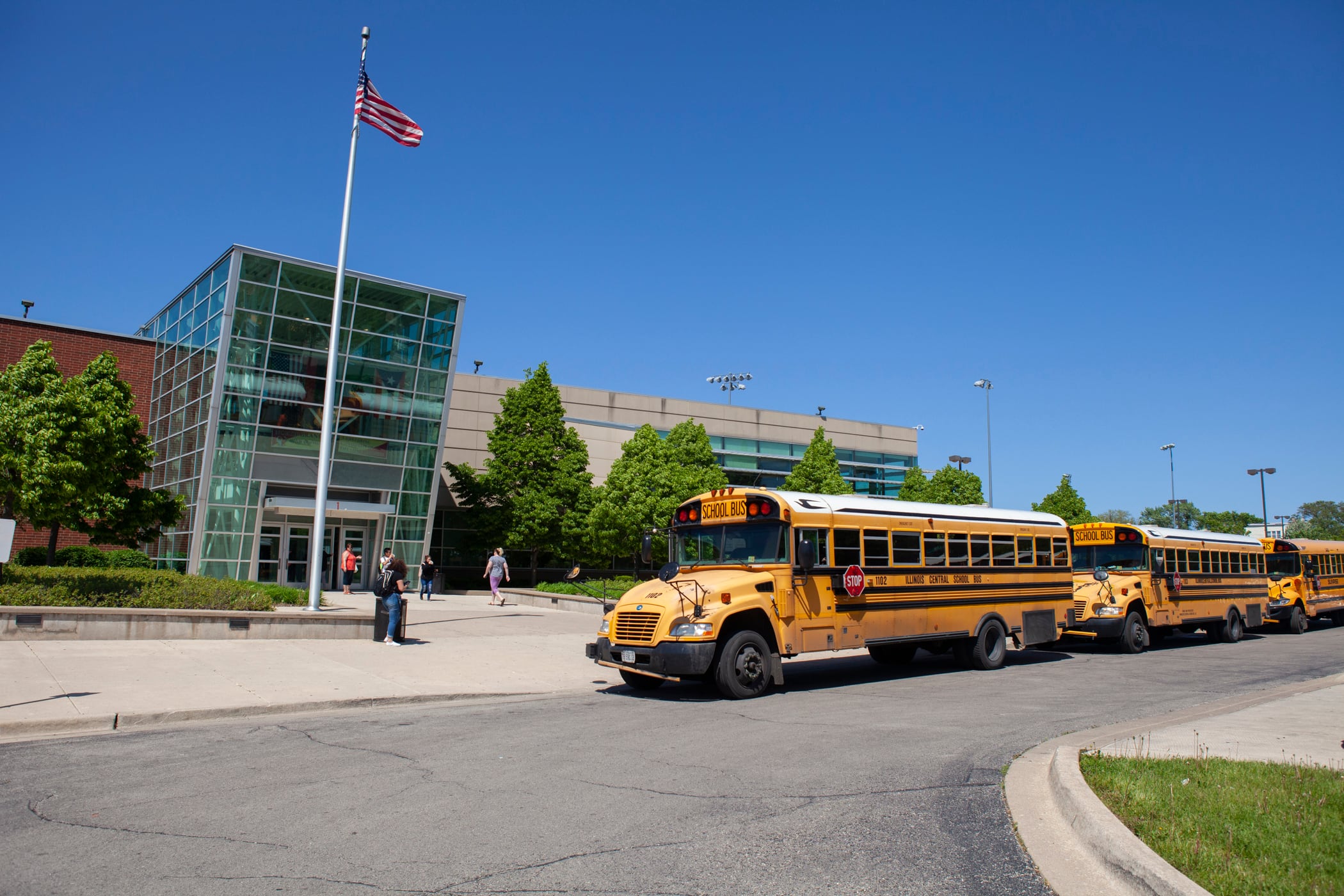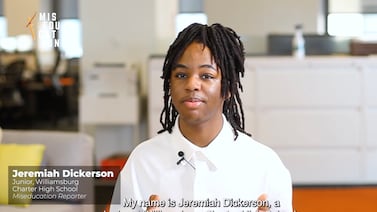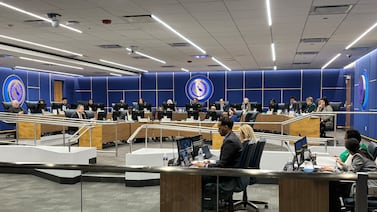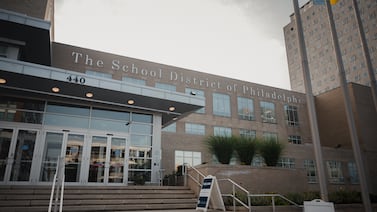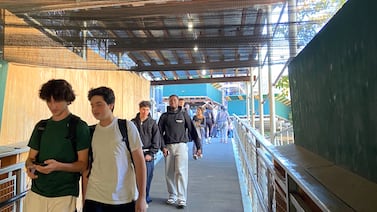Chicago’s $8.4 billion budget plan for its public schools includes $125 million in new classroom investments and a second $75 million infusion for the district’s pandemic response — new spending that gambles on Congress coming through with additional emergency funding for schools despite recently stalled talks in Washington.
The school district is also planning to cut its controversial tab for school police at least in half. The $33 million contract between the city’s schools and its police department recently has come under intense scrutiny.
Overall, the budget proposal is a 7% increase over an amended $7.84 billion budget that the school board passed in November after an 11-day strike ushered in a new contract with the teachers’ union. The plan unveiled Monday includes $758 million in capital spending, including $653 million for bathroom upgrades, new science labs, roof repairs, playground upgrades and sports fields across the city and $50 million to build a new South Side high school.
The added spending banks on the feds delivering on proposals for a second school bailout package, a follow-up to last spring’s coronavirus relief effort. At least one state, California, is also budgeting with the assumption that this financial injection will come through, but the approach could be risky given deep disagreement about the amount and fine print between Democrats and Republicans in Congress.
“There’s risk there,” says Marguerite Roza, an education finance expert who is director of the Edunomics Lab at Georgetown University. “Even if there is bipartisan support for a dollar figure, we don’t know the details. Is it for two years or three years? What strings are attached to that money? Will districts be required to open?”
In Chicago, which is starting the school year remotely, district officials acknowledged that a stalled second stimulus effort is putting Chicago and other districts in a tough spot. Still, they noted that the $343 million in such financial support they budgeted is less than what Chicago would receive under even the most conservative proposal in Congress; they argued that there is strong bipartisan support for channeling more money to schools grappling with the financial fallout from the coronavirus pandemic.
“We wouldn’t be putting out this budget proposal if we didn’t believe the federal government was going to support CPS and other districts,” said school chief Janice Jackson. “We think it’s irresponsible to put out a budget assuming the federal government will do nothing.”
Jackson said that if Congress penalizes districts financially for kicking off the school year virtually as some lawmakers have threatened, “We will address that as it comes.”
Broken down by category, the budget proposal lays out a $6.9 billion operating budget for district schools, charters, and administrative expenses, $711 million in spending to manage the district’s debt, and $758 million in capital expenses. The Chicago Board of Education will vote on the proposed budget on Aug. 26.
District officials said they prioritized facility projects in the city’s highest-need communities, using for the first time a new “equity index” to steer resources to upgrade and repair schools that serve primarily low-income students.
“Even amidst the unprecedented challenges created by the COVID-19 crisis, we continue to lead with our values of equity and inclusion, especially when it comes to our children and their educational future,” Mayor Lori Lightfoot said in a statement.
The proposed reduction in school police expenses comes thanks to a credit it will receive for non-instructional days — both during the summer and the first quarter of all-virtual learning this fall — and the fact that the district will no longer pay expenses for mobile patrol officers who responded to calls from multiple schools.
On Twitter, the Chicago Teachers Union, which has called for pulling police officers out of the schools, hailed the reduction in police spending. It urged the district to invest in digital access and support for the families of essential workers and support staff.
Pandemic-related spending
The district said an additional $75 million in COVID-19 related expenses — beyond an earlier $75 million in emergency spending the school board authorized last spring — will help support both remote learning at the school year’s start and a possible shift to a blend of in-person and virtual instruction later in the year. The money will pay for more computers and other technology, personal protective equipment, cleaning supplies, free school meal deliveries, and more.
The district’s chief operating officer, Arnie Rivera, vowed that any student who needs a computer will receive one from the district and highlighted a new initiative called “Chicago Connected” to provide free high-speed internet to low-income students. He said the district is “moving aggressively” to address a digital divide that complicated Chicago’s abrupt shift to remote learning this past spring. The district, which handed out more than 100,000 devices last spring, has not said yet how many families have signed up for “Chicago Connected” since the city launched the program back in June with philanthropic support.
The district is also using $128 million out of the $206 million it is expected to receive from the first coronavirus relief package, with the remainder covering expenses from this past school year. The district saved about $10 million on field trip transportation, substitute teachers, and other expenses after the pandemic shuttered school buildings in March.
District leaders estimate that the budget still falls $1.9 billion short of what it should take to fully fund education for Chicago’s 355,000 students. When Illinois revamped its state funding formula in 2017, it set spending targets for every district in the state according to student need and how much local revenue is available to meet that need. Chicago is among the districts furthest from the goal.
Focus on repairing schools
A more restrained facility budget than the district has adopted in recent years, the $758 million in capital expenditures includes $653 million that will go toward what the district described as critical renovations at neighborhood schools, with a priority on restroom repairs. It also includes money to make school buildings more accessible for people with disabilities — part of a five-year $100 million investment — as well as dollars for new pre-kindergarten classrooms, science labs, South Side sports complexes, new playgrounds, and spaces for new academic programs.
Officials noted that, unlike in previous years, the capital budget is dedicated largely to maintaining and repairing campuses rather than building new schools. The district does plan to pay for an addition to Sauganash Elementary, which officials described as a “heavily overcrowded” school that draws students almost exclusively from its surrounding neighborhood on Chicago’s Northwest Side.
The budget includes an added $50 million allocation from the state to build a new high school on the Near South Side. Previously, the district had pushed to close a popular South Side elementary school and reopen it as a high school — a proposal that drew widespread controversy. After protests and a court-ordered freeze on the school closure, Chicago ultimately withdrew the plan.
The district, which owes more than $8 billion, will borrow money at some point this fall to pay for some of its capital spending, though the amount has not been determined yet, chief financial officer Miroslava Krug said.
Of the $1.85 billion Chicago is getting from the state, $446 million will be used to help service its debt, a $64 million increase over the previous fiscal year.
Academic investments
Roughly $4.1 billion of the proposed spending will go directly to Chicago’s campuses.
The $125 million in new classroom spending includes $44 million in previously announced “equity grants” to support schools with flagging enrollment and other needs. Money budgeted for the grants of up to $700,000, which serve as key lifelines for some of the city’s shrinking schools, increased from $33 million last year to $44 million.
The district, which agreed to beef up the ranks of key support staff as part of contract negotiations with its teachers union, is staffing a record number of school nurses, social workers, and special education case managers. Chicago is planning to spend $13 million to hire 55 additional nurses, 44 social workers and 40 case managers, though officials noted nationwide shortages of such professionals.
Officials touted the largest ever budget boost for special education, which comes on the heels of what families and advocates have described as particularly challenging spring for students with special needs and their families.
Jackson said the district is hiring additional special education teachers to enable more small-group instruction and one-on-one support — both during remote learning and once students return to school buildings.
“We expect to see a dramatic improvement in our services,” she said.
The district is hosting a series of five virtual community meetings to discuss its operating and capital budgets separately Aug. 18 through Aug. 21. For more information, and the complete budget proposal, visit www.cps.edu/budget.
Cassie Walker Burke contributed reporting.

